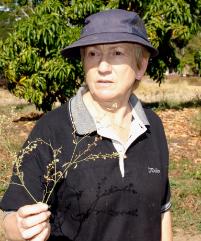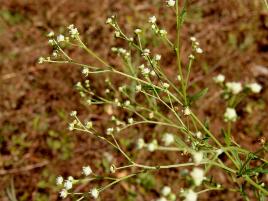Parthenium, More than a Weed, a Health Menace
Published on 20 October, 2009
Diane Goldsworthy's background in nursing, with a focus on community health, led to her developing an interest in allergies and immunology. That, combined with a chance meeting with a Central Queensland grazier who'd had a nasty experience with the weed, resulted in her pursuing research on Parthenium hysterophorus. Diane recently presented a paper on the topic.
Diane said, "The problem with Parthenium is that the whole of the plant is poisonous; when one tends to think of allergies, we think of pollens, spores, flowers, or seeds, but with Parthenium all of it is toxic."
Whether it is handled when flowering or not, even if a person comes into contact with desiccated bits of it, the risk is there that that person will have a reaction to it if sensitised to the plant. Ms Goldsworthy added, "What makes it even more dangerous is that one can be sensitised to it, and not know about it. Only until you come into contact with it again and suffer an allergic reaction, will you be aware that you have been sensitised, and that is likely to stay with you." ... 
Diane Goldsworthy
Diane said, "The problems she and health instrumentalities have is raising community awareness of the health issues." She said it's generally considered to be a farmer's, or pastoralist's problem, a general laissez faire attitude develops in the populated centres, and the response is usually, "Oh! Well, it makes me sneeze, whatever!"
Diane warns that the weed is going to be more of a health problem for more populous communities, not just those ‘out West'. People who have allergies and who come into contact with Parthenium are at great risk of having a reaction to it, particularly if the person already has an allergy to pollens, flowers etc. the chances are that person will develop a Parthenium-specific allergy.
As to the observable manifestation of a reaction, there are many variations, however, common are conjunctivitis, respiratory problems, particularly with asthmatics, and even if there is no skin reaction, the allergic response will happen.
Diane concluded by saying, "There are treatments for the symptoms of Parthenium poisoning, there's no cureand there's no de-sensitisation program, because nobody's researched it sufficiently to date!"
Her advice for persons who know they are allergic to it is to avoid it completely. If contact is made all unprotected skin should be washed in cold water, particularly the face. Persons who know there's a likelihood they may contact the plant should take antihistamines prior to their journey, and asthmatics should have their medication at hand... 
Parthenium hysterophorus
The pest came out from North America in the 1950s with a cargo of contaminated wheat. There were two areas, Toogoolawah in 1955 and Clermont in 1960, which were noticeably affected. The worst infestation being in the Clermont, Central Queensland region in the 1970s after protracted rain. The plant is a voluminous seeder and the seeds, which can be dispersed by a decent wind, are very long-lived, lying dormant in the soil for extended periods.
Parthenium is a declared Class 2species under the Queensland Land Protection (Pest and Stock Route Management) Act 2002. More detail is available from the Department of Primary Industries.

